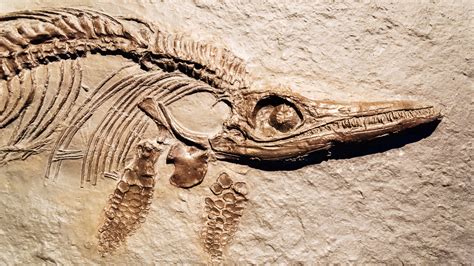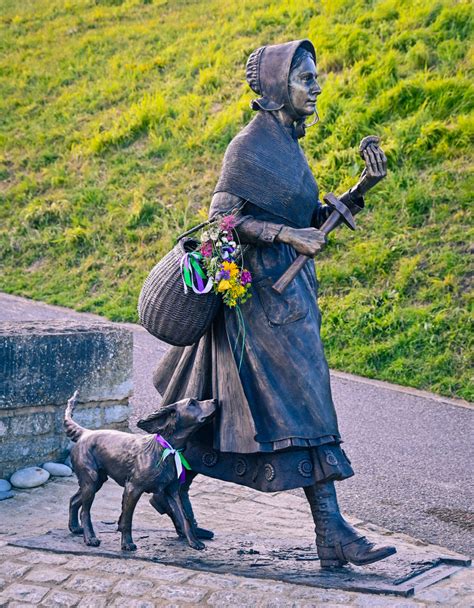In the 19th century, a tenacious and daring explorer embarked on a groundbreaking journey, unraveling the mysteries of a bygone era. This remarkable individual, a pioneer in her field, dedicated her life to the thrilling pursuit of ancient relics buried deep within the earth's crust. With unwavering determination and an insatiable curiosity, she defied societal norms and shattered glass ceilings, leaving an indelible mark on the world of paleontology.
This extraordinary figure, born in 1799 and departing from this world in 1847, played a pivotal role in the field of scientific discovery. She possessed an unparalleled passion for unearthing fragments of the past, carefully studying and piecing together the remains of long-extinct creatures. Despite facing various obstacles, including the limitations imposed on women during her time, she emerged as a trailblazer, reshaping our understanding of prehistoric life.
But who was this intrepid soul? What drove her relentless pursuit, way ahead of her time? Though her name may not be widely recognized, her contributions to paleontology have left an indelible imprint on the scientific landscape. This biography aims to delve into the extraordinary life and achievements of Mary Anning, shedding light on her groundbreaking discoveries and the societal context in which she operated. Join us as we embark on a captivating journey through the life of a true pioneer, whose legacy continues to captivate and inspire modern scientists and enthusiasts alike.
Discoveries and Contributions to Paleontology

In the world of paleontology, few names stand out as brightly as Mary Anning's. Her groundbreaking discoveries and significant contributions to the field have forever shaped our understanding of prehistoric life. Anning's invaluable work in uncovering and interpreting fossils have paved the way for countless scientific advancements and sparked a passionate curiosity in the study of ancient lifeforms.
Anning's remarkable skill in fossil hunting allowed her to unearth a plethora of important specimens. She meticulously excavated fossils from the Jurassic cliffs of Lyme Regis in England, revealing a wealth of information about long-extinct marine creatures. Her discoveries included the remains of iconic creatures such as ichthyosaurs, plesiosaurs, and pterosaurs, providing scientists with vital evidence of their existence and ancient adaptations.
But Anning's contributions went beyond mere discoveries. She possessed an innate ability to interpret and understand the fossils she found, utilizing her keen eye for detail and extensive knowledge of anatomy. Anning's meticulous observations and accurate reconstructions played a pivotal role in reconstructing the anatomy and behavior of long-extinct organisms, revolutionizing the field of paleontology.
Furthermore, Anning's work challenged prevailing beliefs and fueled scientific debates. She discovered a complete skeleton of a plesiosaur, which was initially met with skepticism and controversy. However, Anning's relentless pursuit of scientific truth and her unyielding support from the scientific community ultimately led to her discoveries being recognized and admired.
The impact of Mary Anning's contributions to paleontology cannot be overstated. Her discoveries not only provided valuable insights into Earth's ancient history but also inspired generations of scientists to explore and unravel the mysteries of prehistoric life. Anning's passion, perseverance, and remarkable achievements continue to shape the field of paleontology, making her a true pioneer in the scientific world.
Challenges and Barriers faced by a Female Scientist
Being a woman in the scientific community during the 19th century presented a myriad of obstacles and limitations that hindered the progress and recognition of female researchers and scholars. In a time when gender roles were strictly defined, women faced numerous challenges in pursuing scientific endeavors and breaking through the barriers that were imposed upon them.
Women such as Mary Anning had to overcome societal norms that deemed intellectual pursuits as unfeminine and inappropriate. They often lacked access to formal education, scientific institutions, and resources necessary for conducting research. The prevailing belief was that women were inherently inferior and lacked the intellectual capabilities to make significant contributions in scientific fields.
Moreover, female scientists faced a significant lack of recognition and acknowledgement for their work, as their accomplishments were often undermined or attributed to male counterparts. Their scientific achievements were overshadowed by biases and prejudices, resulting in limited opportunities for career advancement and the public acknowledgment of their contributions to scientific knowledge.
Additionally, the scientific community itself posed another barrier for female scientists. Many societies and organizations excluded women from professional networks and conferences, denying them the chance to engage with their peers and exchange ideas. This isolation further impeded their ability to collaborate, share knowledge, and gain credibility within the scientific community.
Despite these obstacles, remarkable women like Mary Anning defied societal expectations and made groundbreaking contributions in their respective fields. Through their resilience, determination, and sheer passion for science, they paved the way for future generations of female scientists and shattered the glass ceiling that limited their opportunities for success.
Today, we recognize the importance of addressing gender disparities in the scientific field and strive to create an inclusive environment that values the contributions and expertise of women. The challenges faced by women like Mary Anning serve as a reminder of the immense talent and potential that can be unlocked by breaking down barriers and embracing diversity within the scientific community.
Collaborations and Scientific Recognitions

The significant contributions of Mary Anning were not only limited to her independent discoveries, but also extended to her collaborations with fellow scientists and the recognition she received within the scientific community. Through her collaborations, Anning was able to share her knowledge, insights, and specimens with other researchers, ultimately advancing our understanding of prehistoric life and the geological history of the Earth.
Anning's passion for fossils and her exceptional skills as a collector and preparator attracted the attention of prominent scientists of her time. These scientific collaborations allowed her to exchange ideas and information, further enhancing her own expertise and contributing to the collective knowledge of the field. She actively corresponded with renowned geologists and paleontologists, engaging in intellectual discussions and exchanging valuable specimens, artifacts, and data.
Her tireless efforts and meticulous documentation of her discoveries garnered recognition and respect from both her fellow scientists and the wider scientific community. Anning was acknowledged as an expert in her field and her expertise was sought after by scientists from various disciplines. She earned the respect and admiration of her contemporaries, who recognized her as a pioneer in the field of paleontology and considered her findings as fundamental to the understanding of extinct species and the geological formations in which they were found.
Furthermore, Anning's contributions were not only recognized during her lifetime, but have continued to be celebrated and appreciated by scientists and historians long after her passing. Her discoveries shaped the foundation of paleontological research and continue to inspire generations of scientists to uncover the mysteries of the Earth's past.
In conclusion, Mary Anning's collaborations with fellow scientists and the scientific recognitions she received for her groundbreaking work played a crucial role in advancing the field of paleontology and our understanding of the natural world. Her contributions continue to be revered and stand as a testament to her extraordinary intellect, perseverance, and dedication to the pursuit of knowledge.
Impact and Legacy in the Field of Paleontology
The contributions and lasting influence of Mary Anning in the field of paleontology have left an indelible mark on the scientific community. Her groundbreaking discoveries and pioneering research revolutionized our understanding of prehistoric life and laid the foundation for future paleontological studies.
1. Inspiring Future Generations: Anning's perseverance and dedication to her work serve as an inspiration to aspiring paleontologists worldwide. Her story showcases the power of passion, determination, and a love for discovery, encouraging young scientists to pursue their dreams in the face of adversity.
2. Advancing Knowledge of Extinct Species: Through her meticulous excavation and analysis of fossils, Anning significantly expanded the known catalog of extinct species. Her discoveries of marine reptiles, including the iconic ichthyosaur and plesiosaur, provided crucial evidence for the existence and diversity of prehistoric creatures that once roamed the Earth's oceans.
3. Uncovering Ancient Ecosystems: Anning's findings not only shed light on individual species but also contributed to a deeper understanding of ancient ecosystems. By piecing together fossils from various organisms found in the same geological layers, she reconstructed the complex interactions between different species and their environments, offering invaluable insights into the Earth's past biodiversity.
4. Challenging Gender and Social Norms: Anning's success as a female scientist in the early 19th century challenged prevailing gender and social norms. Despite facing numerous obstacles due to her gender and socioeconomic background, she gained recognition and respect within the scientific community, paving the way for future generations of women in science.
5. Preservation of Geological Heritage: Anning's innovative methods of careful excavation and meticulous documentation set the standard for fossil preservation and collection practices. Her meticulous records and meticulous labeling of specimens ensured their scientific value and accessibility for future research, contributing to the preservation of geological heritage.
- By inspiring future generations
- By advancing knowledge of extinct species
- By uncovering ancient ecosystems
- By challenging gender and social norms
- By preserving geological heritage
Through her impactful contributions, Mary Anning's legacy endures in the field of paleontology, forever shaping our understanding of the ancient world and inspiring generations to continue exploring the wonders of our planet's past.
Remembering Mary Anning: Museums, Monuments, and Homages

In this section, we explore the lasting impact and recognition of Mary Anning's contributions to paleontology and her role as a trailblazer in the field. Through various museums, monuments, and homages dedicated to her, Anning's legacy continues to inspire and educate generations.
Museums: Several museums around the world showcase Mary Anning's remarkable discoveries and provide insights into her life and work. These institutions preserve and display Anning's fossils, artifacts, and scientific findings, allowing visitors to immerse themselves in her groundbreaking work. Through carefully curated exhibits, these museums shed light on Anning's significant contributions to the field of paleontology, emphasizing her pioneering spirit and the challenges she overcame as a woman in a male-dominated scientific community. | Monuments: Monuments dedicated to Mary Anning stand as tangible symbols of her enduring legacy. These statues and plaques commemorate her achievements, honoring her as a pioneering figure in the scientific world. Located in significant sites connected to Anning's life and work, these monuments serve as reminders of her determination, perseverance, and the valuable contributions she made to our understanding of prehistoric life. |
Homages: The influence of Mary Anning extends beyond physical representations in museums and monuments. Her name lives on through various homages, such as books, documentaries, and educational programs that celebrate her achievements. Authors, filmmakers, and educators continue to shed light on Anning's remarkable story, ensuring that future generations recognize her as a pioneer and role model. These homages highlight Anning's contributions to science and emphasize the importance of gender equality and inclusivity in scientific exploration. | |
FAQ
Who was Mary Anning?
Mary Anning was a pioneer fossil hunter and paleontologist. She lived from 1799 to 1847 and made significant contributions to the world of paleontology.
What were some of Mary Anning's major discoveries?
Mary Anning made several important fossil discoveries, including the first complete Ichthyosaur skeleton, a complete Plesiosaur skeleton, and numerous other fossils from the Jurassic period. Her discoveries greatly helped in the understanding of extinct marine reptiles.
How did Mary Anning become interested in fossil hunting?
Mary Anning's interest in fossil hunting began at a young age. She would often accompany her father on his fossil-finding expeditions along the cliffs of Dorset, England. Her father taught her how to identify and collect fossils, sparking her passion for paleontology.



